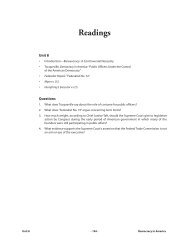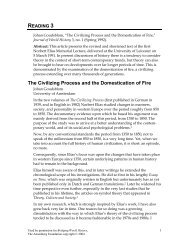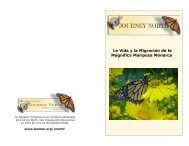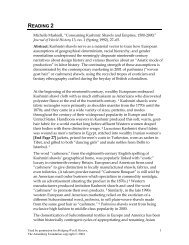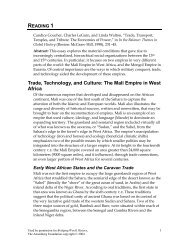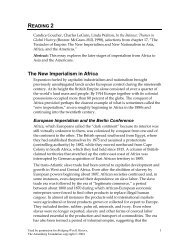UTOPIAN PROMISE - Annenberg Media
UTOPIAN PROMISE - Annenberg Media
UTOPIAN PROMISE - Annenberg Media
Create successful ePaper yourself
Turn your PDF publications into a flip-book with our unique Google optimized e-Paper software.
[4433] Michael Wigglesworth, The Day<br />
of Doom. Or, A Short Description of the<br />
Great and Last Judgment. With a Short<br />
Discourse about Eternity. By Michael<br />
Wigglesworth. The Seventh Edition,<br />
Enlarged. With a Recommendatory<br />
Epistle (in Verse) By the Rev. Mr. John<br />
Mitchel (1715), courtesy of the Tracy W.<br />
McGregor Library of American History,<br />
University of Virginia.<br />
34 UNIT 3, <strong>UTOPIAN</strong> <strong>PROMISE</strong><br />
of scriptural predictions in order to pinpoint the exact day that New<br />
England would herald the Apocalypse, the time at which Christ<br />
would return and reign for a thousand years. According to the<br />
Puritans, this millennium would usher in the end of history: the earth<br />
would be destroyed, the elect would be ushered into heaven, and all<br />
others would be cast into hell.<br />
The centrality of millennial apocalyptic beliefs to Puritan culture<br />
can be indexed by the extraordinary popularity of Michael<br />
Wigglesworth’s poem “The Day of Doom.” With its terrifying images of<br />
hellfire and damnation and its stern accounts of God’s wrathfulness,<br />
the poem might seem grim and unappealing to modern readers. But<br />
Wigglesworth’s lengthy verse description of the Apocalypse was a bestseller<br />
among seventeenth-century Puritans; scholars estimate that<br />
after its publication in 1662, one copy existed for every twenty-five<br />
New Englanders. Many Puritans were apparently moved to learn its<br />
224 eight-line stanzas by heart. As the title indicates, the action takes<br />
place on Judgment Day, when a vengeful Christ divides humanity into<br />
two groups: the righteous sheep at his right hand and the sinful goats<br />
at his left. The goats’ wickedness and religious heresy are exposed, and<br />
they are condemned to a burning lake in hell. The poem graphically<br />
describes the horrific punishments awaiting the non-elect:<br />
With iron bands they bind their hands,<br />
and cursed feet together,<br />
And cast them all, both great and small,<br />
into that lake forever.<br />
Where day and night, without respite,<br />
they wail, and cry, and howl,<br />
For tort’ring pain, which they sustain<br />
in body and in soul.<br />
With its plain language and catchy rhyme scheme, “The Day of<br />
Doom” functioned for Puritans as a kind of “verse catechism,” useful<br />
for teaching basic theological tenets. It frequently was employed to<br />
instruct children, who would thus grow up with a thorough understanding—however<br />
terrifying such knowledge might have been to<br />
them—of the coming Apocalypse.<br />
In this cultural climate, death was approached with both fear and<br />
ecstatic expectancy, for it could bring either eternal torment or admittance<br />
to everlasting paradise. Only upon death could Puritans finally<br />
resolve the spiritual uncertainty that dominated their lives: death<br />
offered final and incontrovertible proof of their spiritual identity as<br />
either sheep or goats. The importance of death within Puritan culture<br />
is signaled by the attention they gave to funerary customs, including<br />
the carving of tombstones. Prior to the mid-1650s, Puritans usually<br />
left graves unmarked or indicated them only by simple wooden markers.<br />
Such non-decorative practices accorded with Puritans’ rejection<br />
of all religious imagery as idolatrous “graven images” such as the Bible<br />
forbade. But by the 1660s, Puritans’ preoccupation with death led<br />
them to erect elaborately carved gravestones decorated with symbolic<br />
images and engraved with language that both commemorated the



